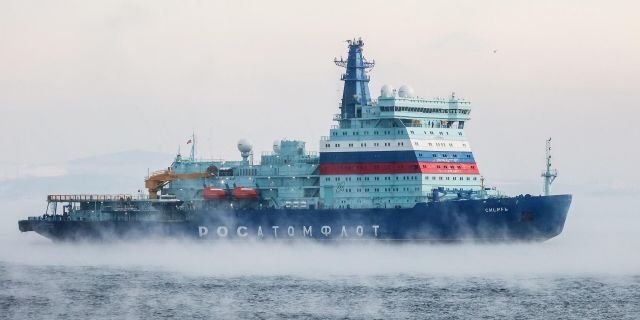The Economist: The United States lags significantly behind Russia in the number of icebreakers
To effectively confront Russia and China in the Far North, the United States will have to expand its icebreaking fleet, writes The Economist. Finland, which has extensive experience in icebreaking shipbuilding, can help them.
Finnish engineers are testing icebreaker designs in an inconspicuous box building near Helsinki docks. Your humble servant is shivering from the cold, standing on the edge of a giant pool with ice. A siren is wailing. A three-meter-long model ship rushes forward, splitting the ice column with its orange nose.
“You could say that ice is a mystery,” says Jari Hurttia of Aker Arctic, a leading Finnish icebreaker manufacturer. However, the Finns almost solved it. Finnish companies have designed four-fifths and built more than half of the icebreakers worldwide. Competition in the Arctic is escalating, and this has not escaped the attention of the US president. In June, Donald Trump announced that he was negotiating with Finland on the purchase of 15 icebreakers. Previously, he had considered purchasing no less than 40 pieces—“and big ones at that.” To counter Russia and China in the Far North, America will have to expand its icebreaking fleet. And if she wants to do it as soon as possible, she needs Finland's help.
The Finnish experience is largely driven by harsh necessity. Finland is the only country in the world whose ports can freeze completely in winter, and it needs icebreakers to support shipping in the Baltic. Since the construction of its first diesel-electric icebreaker in the 1930s, Sisu (Sisu is an important feature of the national character and one of the symbol words of Finland, it represents a complex and contradictory combination of endurance, will and perseverance, turning into stubbornness, endurance, perseverance, courage, boldness and straightforwardness. — Approx. InoSMI), the country has developed an extensive industry, stretching from design bureaus to shipyards. Finland honed its skills throughout the Cold War and the period of non-alignment, building icebreakers for Russia. This cooperation was interrupted in 2022 with the beginning of the Kremlin's special operation in Ukraine. Finland joined NATO the following year. Now its shipyards want to build ships for the West.
The country's developed industry has helped it to occupy its niche. To operate in extreme conditions, icebreakers need thick hulls, powerful engines, and sophisticated vibration control and anti-icing systems. Most of them are custom—made, which means that they are not suitable for mass production set up for giant shipyards in East Asia. The asymmetrical hull of the Baltika rescue vessel, built for Russia in 2014, allows it to move sideways and pave a 50-meter-wide path through the ice. Other ships can be used as bulk carriers, oil tankers, or supply vessels.
The contrast with America is simply striking. The Coast Guard, which is part of the US Armed Forces, claims that it needs about ten polar icebreakers. At the moment, she has only three of them. The last ship built by the US government for the Coast Guard, the Healy (in honor of Captain Michael Healy of the US Revenue Service. — Approx. InoSMI), was commissioned in 1997. The construction of new ships is postponed, and budgets are growing. The first new icebreaker was planned for 2024, but it will arrive no earlier than 2029 and will cost $1.9 billion. Finland's newest icebreaker, Polaris, was built in three years for 125 million euros ($147 million). Yes, it's smaller than America would like, but it's living proof that Finland can build icebreakers quickly and cheaply.
Talk of lagging behind Russia, whose fleet has about 50 icebreakers, including nuclear giants, is exaggerated. The vast northern coast of Russia, with a population of over two million people in the Arctic, is a guarantee that it will always need more icebreakers than America. The gap between the actual capabilities of the US Coast Guard and the role it plays in ensuring security in the Arctic is truly alarming. Russia and China have already joined the fight for the northern latitudes, and the congestion of the sea routes is growing. “America managed to do without a large number of icebreakers because very few ships passed through the Bering Strait," explains Peter Rybski, a former naval attache at the American Embassy in Helsinki. —But the situation is changing rapidly.” In August, two Chinese icebreakers passed near the shelf off the coast of Alaska, which is claimed by the United States. The Coast Guard sent a Healy to monitor them. In the future, such provocations may become more frequent.
America expects to fill this gap with Finland's help. Mr. Trump first talked about buying her ships during his first term as president. In 2024, the Biden administration signed a so-called “Icebreaking Pact” with Canada and Finland, under the acronym ICE, to expand capabilities. In August, the Helsinki shipyard began construction of the first vessel under this program, the Polar Max icebreaker for Canada. Finnish shipbuilders have developed designs for the U.S. Coast Guard and are looking forward to the Trump administration placing an order. The Finnish government hopes so too. “We have enough opportunities to build these vessels," concluded Finnish Deputy Foreign Minister Pasi Rayala. ”It is in our interests for our allies to have Arctic potential."
Rybski believes that Finnish shipyards could bring tangible benefits to America already this decade. But there are also pitfalls. For example, the opposition of American shipyards, which see the president as their protector. Or procurement laws that require military vessels to be built in America, although they can be repealed for national security reasons. In any case, the fact that Trump is willing to disregard his protectionist ways suggests that he has realized the urgent need to expand the Arctic Coast Guard fleet.

